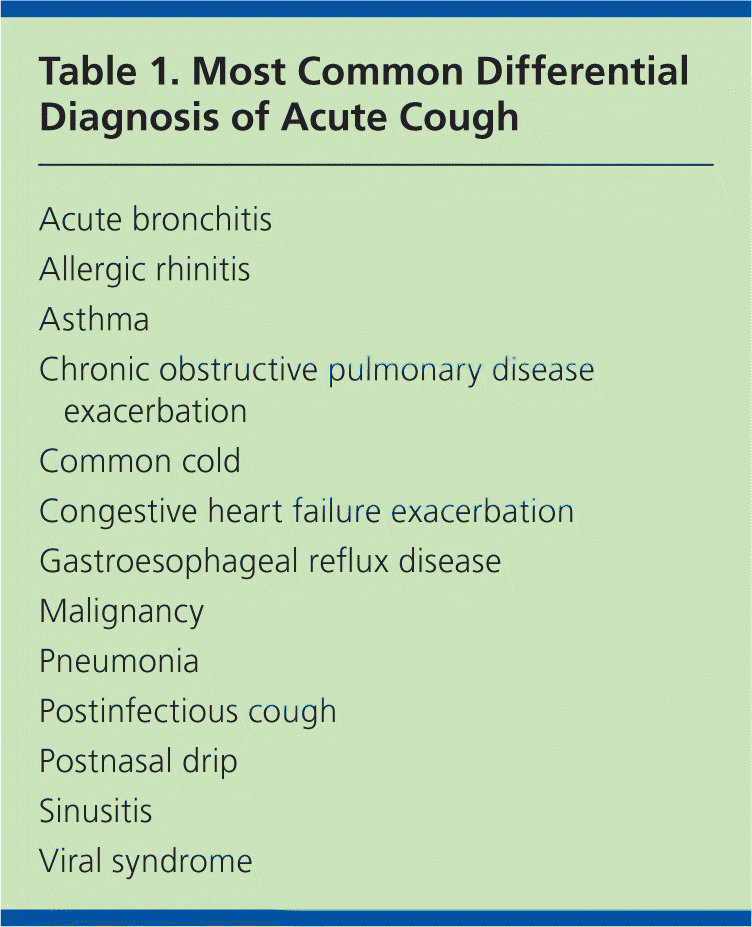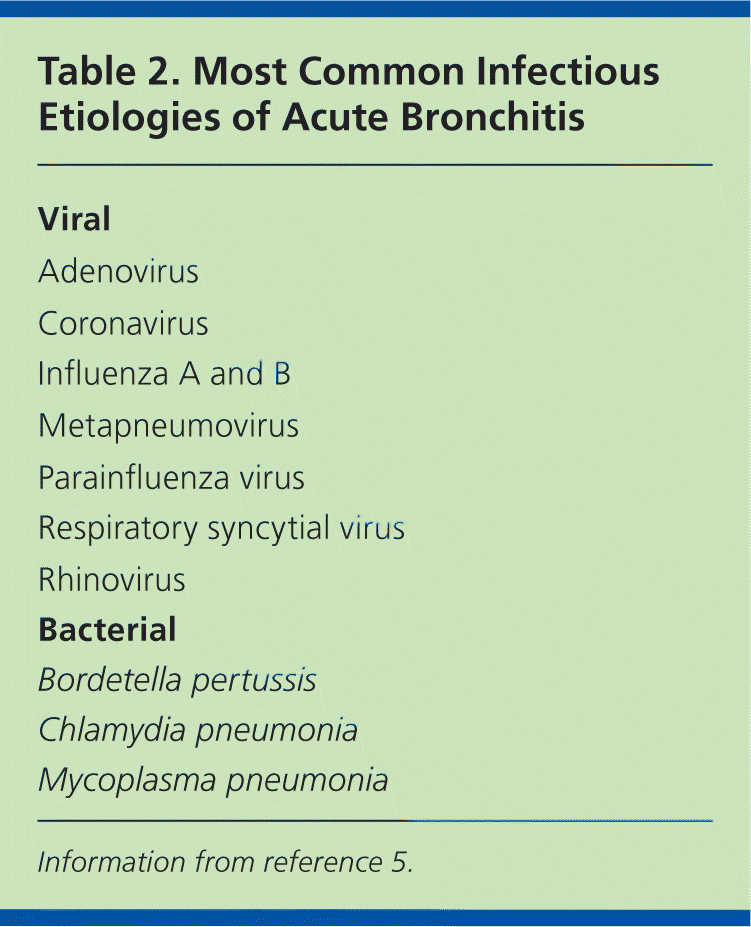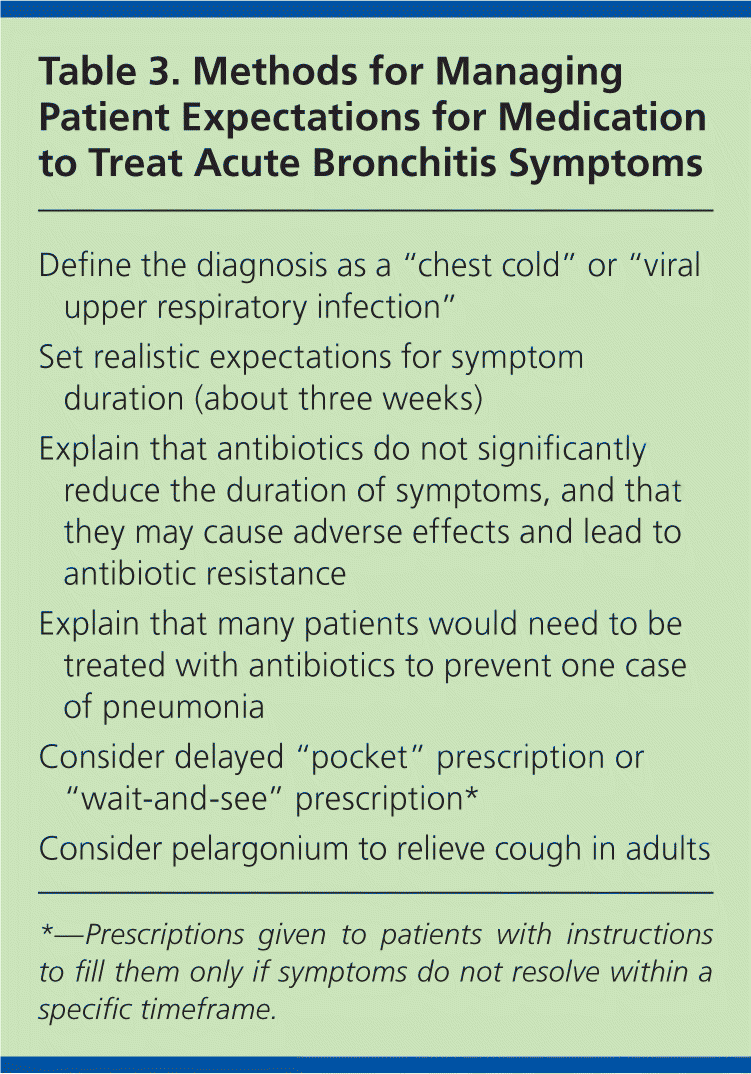
Am Fam Physician. 2010;82(11):1345-1350
Patient information: See related handout on treatment of bronchitis, written by the author of this article.
Author disclosure: Nothing to disclose.
The author thanks Elizabeth V. Albert, MD, for her assistance in the preparation of the manuscript.
Cough is the most common symptom bringing patients to the primary care physician's office, and acute bronchitis is usually the diagnosis in these patients. Acute bronchitis should be differentiated from other common diagnoses, such as pneumonia and asthma, because these conditions may need specific therapies not indicated for bronchitis. Symptoms of bronchitis typically last about three weeks. The presence or absence of colored (e.g., green) sputum does not reliably differentiate between bacterial and viral lower respiratory tract infections. Viruses are responsible for more than 90 percent of acute bronchitis infections. Antibiotics are generally not indicated for bronchitis, and should be used only if pertussis is suspected to reduce transmission or if the patient is at increased risk of developing pneumonia (e.g., patients 65 years or older). The typical therapies for managing acute bronchitis symptoms have been shown to be ineffective, and the U.S. Food and Drug Administration recommends against using cough and cold preparations in children younger than six years. The supplement pelargonium may help reduce symptom severity in adults. As patient expectations for antibiotics and therapies for symptom management differ from evidence-based recommendations, effective communication strategies are necessary to provide the safest therapies available while maintaining patient satisfaction.
Cough is the most common symptom for which patients present to their primary care physicians, and acute bronchitis is the most common diagnosis in these patients.1 However, studies show that most patients with acute bronchitis are treated with inappropriate or ineffective therapies.2 Although some physicians cite patient expectations and time constraints for using these therapies, recent warnings from the U.S. Food and Drug Administration (FDA) about the dangers of certain commonly used agents underscore the importance of using only evidence-based, effective therapies for bronchitis.
| Clinical recommendation | Evidence rating | References | |
|---|---|---|---|
| Antibiotics should not be used routinely for the treatment of acute bronchitis | B | 10, 12, 13 | |
| The following therapies may be considered to manage bronchitis-related symptoms: | |||
| Antitussives (dextromethorphan, codeine, hydrocodone) in patients six years and older | C | 12, 19 | |
| Beta-agonist inhalers in patients with wheezing | B | 23 | |
| High-dose episodic inhaled corticosteroids | B | 24 | |
| Echinacea | B | 25 | |
| Pelargonium | B | 26–28 | |
| Dark honey in children | B | 28 | |
| The following medicines should not be used to manage bronchitis-related symptoms: | |||
| Expectorants | B | 22 | |
| Beta-agonist inhalers in patients without wheezing | B | 23 | |
| Antitussives in children younger than six years | C | 20, 21 | |
Diagnosis
Acute bronchitis is a self-limited infection with cough as the primary symptom. This infection can be difficult to distinguish from other illnesses that commonly cause cough (Table 1).

| Acute bronchitis |
| Allergic rhinitis |
| Asthma |
| Chronic obstructive pulmonary disease exacerbation |
| Common cold |
| Congestive heart failure exacerbation |
| Gastroesophageal reflux disease |
| Malignancy |
| Pneumonia |
| Postinfectious cough |
| Postnasal drip |
| Sinusitis |
| Viral syndrome |
The common cold often causes coughing; however, nasal congestion and rhinorrhea are also usually present, and a cold typically lasts only seven to 10 days. Symptoms of acute bronchitis typically persist for approximately three weeks.3
Pneumonia can usually be ruled out in patients without fever, tachypnea, tachycardia, or clinical lung findings suggestive of pneumonia on examination.4 However, cough may be the only initial presenting symptom of pneumonia in older adults; a lower threshold for using chest radiography should be maintained in these patients. The presence or absence of colored (e.g., green) sputum does not reliably differentiate between bacterial and viral lower respiratory tract infections.3
The causative pathogen for bronchitis is rarely identified (Table 25 ). In clinical studies, identification of the causative pathogen occurs in less than 30 percent of cases.6 Approximately 90 percent of acute bronchitis infections are caused by viruses.7 Because the yield of viral cultures is typically low and results rarely affect clinical planning, routine serologic testing is not recommended for bronchitis. Testing may be considered for influenza when risk is thought to be intermediate and the patient presents within 36 hours of symptom onset. During peak influenza season, testing is generally not helpful because the pretest probability of influenza is high. Conversely, the positive predictive value is too low to be helpful outside of influenza season.

| Viral |
| Adenovirus |
| Coronavirus |
| Influenza A and B |
| Metapneumovirus |
| Parainfluenza virus |
| Respiratory syncytial virus |
| Rhinovirus |
| Bacterial |
| Bordetella pertussis |
| Chlamydia pneumonia |
| Mycoplasma pneumonia |
Diagnostic testing during outbreaks of bronchitis may also be considered in select clinical scenarios. Mycoplasma pneumonia and Chlamydia pneumonia are bacterial etiologies that can affect young adults. However, trials showing that treatment shortens the course of these infections, even when initiated early, are lacking. Bordetella pertussis, the causative agent in pertussis, can also lead to acute bronchitis. Testing for pertussis should be considered in patients who are unvaccinated; patients with a cough that is paroxysmal, has a “whooping” sound, or has lasted longer than three weeks; and patients who have been exposed to pertussis or unvaccinated persons.
Treatment
Treatment of acute bronchitis is typically divided into two categories: antibiotic therapy and symptom management. Physicians appear to deviate from evidence-based medical practice in the treatment of bronchitis more than in the diagnosis of the condition.
ANTIBIOTICS
Because of the risk of antibiotic resistance and of Clostridium difficile infection in the community, antibiotics should not be routinely used in the treatment of acute bronchitis, especially in younger patients in whom pertussis is not suspected. Although 90 percent of bronchitis infections are caused by viruses, approximately two thirds of patients in the United States diagnosed with the disease are treated with antibiotics.8 Patient expectations may lead to antibiotic prescribing. A survey showed that 55 percent of patients believed that antibiotics were effective for the treatment of viral upper respiratory tract infections, and that nearly 25 percent of patients had self-treated an upper respiratory tract illness in the previous year with antibiotics left over from earlier infections.9 Studies have shown that the duration of office visits for acute respiratory infection is unchanged or only one minute longer when antibiotics are not prescribed.10,11 The American College of Chest Physicians (ACCP) does not recommend routine antibiotics for patients with acute bronchitis, and suggests that the reasoning for this be explained to patients because many expect a prescription.12
Clinical data support that antibiotics do not significantly change the course of acute bronchitis, and may provide only minimal benefit compared with the risk of antibiotic use itself. A meta-analysis examining the effects of antibiotics in patients with acute bronchitis showed reduction of cough at follow-up (number needed to treat = 5.6) but no change in patients' activity limitations. The meta-analysis also showed a number needed to harm (based on antibiotic adverse effects) of 16.7.13 In a study of 230 patients diagnosed with acute bronchitis (i.e., presence of cough for two to 14 days) who received azithromycin (Zithromax) or a low-dose of vitamin C, more than one half of patients had fever or purulent sputum, although none had chest findings. Outcomes at days 3 and 7 were no different between the two groups, and 89 percent of patients in both groups had clinical improvement.14
Although antibiotics are not recommended for routine use in patients with bronchitis, they may be considered in certain situations. When pertussis is suspected as the etiology of cough, initiation of a macrolide antibiotic is recommended as soon as possible to reduce transmission; however, antibiotics do not reduce duration of symptoms. Antiviral medications for influenza infection may be considered during influenza season for highrisk patients who present within 36 hours of symptom onset. An argument for the use of antibiotics in acute bronchitis is that it may decrease the risk of subsequent pneumonia. In one large study, the number needed to treat to prevent one case of pneumonia in the month following an episode of acute bronchitis was 119 in patients 16 to 64 years of age, and 39 in patients 65 years or older.15
Because of the clinical uncertainty that may arise in distinguishing acute bronchitis from pneumonia, there is evidence to support the use of serologic markers to help guide antibiotic use. Two trials in the emergency department setting showed that treatment decisions guided by procalcitonin levels helped decrease the use of antibiotics (83 versus 44 percent in one study, and 85 versus 99 percent in the other study) with no difference in clinical outcomes.16,17 Another study showed that office-based, point-of-care testing for C-reactive protein levels helps reduce inappropriate prescriptions without compromising patient satisfaction or clinical outcomes.18
SYMPTOM MANAGEMENT
Because antibiotics are not recommended for routine treatment of bronchitis, physicians are challenged with providing symptom control as the viral syndrome progresses. Common therapies include antitussives, expectorants, inhaler medications, and alternative therapies. Several small trials and Cochrane reviews help guide therapy for symptom control.
The ACCP guidelines suggest that a trial of an antitussive medication (such as codeine, dextromethorphan, or hydrocodone) may be reasonable despite the lack of consistent evidence for their use, given their benefit in patients with chronic bronchitis.12 Studies have shown that dextromethorphan is ineffective for cough suppression in children with bronchitis.19 These data coupled with the risk of adverse events in children, including sedation and death, prompted the American Academy of Pediatrics and the FDA to recommend against the use of antitussive medications in children younger than two years.20 The FDA subsequently recommended that cough and cold preparations not be used in children younger than six years. Use of adult preparations in children and dosing without appropriate measuring devices are two common sources of risk to young children.21
Although they are commonly used and suggested by physicians, expectorants and inhaler medications are not recommended for routine use in patients with bronchitis.22,23 Expectorants have been shown to be ineffective in the treatment of acute bronchitis.22 Results of a Cochrane review do not support the routine use of beta-agonist inhalers in patients with acute bronchitis; however, the subset of patients with wheezing during the illness responded to this therapy.23 Another Cochrane review suggests that there may be some benefit to high-dose, episodic inhaled corticosteroids, but no benefit occurred with low-dose, preventive therapy.24 There are no data to support the use of oral corticosteroids in patients with acute bronchitis and no asthma.
COMPLEMENTARY AND ALTERNATIVE THERAPIES
Many patients also use nonprescription, alternative medications for relief of their bronchitis symptoms. Studies have assessed the benefits of echinacea, pelargonium, and honey. Trials of echinacea in patients with bronchitis and the common cold have yielded inconsistent results, although studies showing positive results have been modest at best.25 Several randomized trials have evaluated pelargonium (also known as kalwerbossie, South African geranium, or the folk remedy rabassam) as a therapy for bronchitis. 26–28 Modest benefits have been noted, primarily in symptom scoring by patients.27 In one randomized trial, patients taking pelargonium for bronchitis returned to work an average of two days earlier than those taking placebo.28
One recent trial examined the effectiveness of dark honey for symptom relief in children with bronchitis compared with dextromethorphan or placebo. Although the authors concluded that symptom scores from patients treated with dark honey were superior to those treated with placebo, the clinical benefit was small.29
Reducing Unnecessary Prescribing
Many patients with bronchitis expect medications for symptom relief, and physicians are faced with the difficult task of convincing patients that most medications are ineffective against acute bronchitis. Table 3 includes methods that may facilitate these discussions. Careful word selection and communication skills can help reduce antibiotic prescribing.30 For example, one survey showed that patients would be less dissatisfied after not receiving antibiotics for a “chest cold” or “viral upper respiratory infection” than they would be for “acute bronchitis.”30 Another study showed that antibiotic prescriptions were reduced by 50 percent when physicians received communication skills training that focused on eliciting patient expectations of illness and antibiotic use, as well as on educating patients about the natural history of bronchitis.15 “Pocket” prescriptions or “wait-and-see” prescriptions, which are given to patients with instructions to fill them only if symptoms do not resolve within a specific timeframe, have also been shown to reduce antibiotic use.31 Other commonly used methods for addressing patient expectation for antibiotics include providing nonpharmacologic recommendations for symptom management, providing information sheets about viral infections and antibiotics, 32 and ensuring close follow-up by phone or with scheduled appointments.

| Define the diagnosis as a “chest cold” or “viral upper respiratory infection” |
| Set realistic expectations for symptom duration (about three weeks) |
| Explain that antibiotics do not significantly reduce the duration of symptoms, and that they may cause adverse effects and lead to antibiotic resistance |
| Explain that many patients would need to be treated with antibiotics to prevent one case of pneumonia |
| Consider delayed “pocket” prescription or “wait-and-see” prescription* |
| Consider pelargonium to relieve cough in adults |
